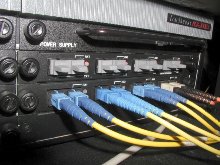Categories: Featured Articles » Interesting Facts
Number of views: 10865
Comments on the article: 0
Instead of a conductor, a dielectric
 In 1870, the English physicist John Tyndall demonstrated an interesting experience in the propagation of light through a stream of water. Light from a carbon arc is introduced through a lens into a water stream. Due to the multiple internal reflections of the rays at the boundary of two media - water and air - the jet glowed along its entire length. It was the first light guide - liquid.
In 1870, the English physicist John Tyndall demonstrated an interesting experience in the propagation of light through a stream of water. Light from a carbon arc is introduced through a lens into a water stream. Due to the multiple internal reflections of the rays at the boundary of two media - water and air - the jet glowed along its entire length. It was the first light guide - liquid.
After 35 years, another scientist, Robert Wood, suggested that "light without large losses can be transmitted from one point to another, using the internal reflection from the walls of a glass stick." So the idea came up solid transparent fiber.
50 years passed from the emergence of this idea to its realization, until in the late 1950s, two-layer glass fibers with different refractive indices were obtained: large in the inner and smaller in the outer layer. As in the Tyndall experiments, due to multiple reflections at the boundary of two media, a light beam propagated along the fiber from the transmitting end to the receiving one.
 When in 1966 an assumption was made about the possibility of using optical fibers to transmit communication signals, for many this seemed utopian. When transmitted over existing fibers at that time, even made of optical glasses, the light beam weakened so quickly that it literally died out after 10 meters.
When in 1966 an assumption was made about the possibility of using optical fibers to transmit communication signals, for many this seemed utopian. When transmitted over existing fibers at that time, even made of optical glasses, the light beam weakened so quickly that it literally died out after 10 meters.
The quality of telephone transmission over the line is considered satisfactory if the signal strength when passing from the transmitting end to the receiving one is weakened by no more than 1000 times. Therefore, the allowable attenuation of the signal power should not exceed 30 decibels.
For the resistance of various materials, specific indicators are used, in this case the attenuation refers to a unit of line length. The attenuation coefficient of optical glasses available in the mid-sixties was 3,000 decibels per kilometer. Hence the above value of the possible transmission range on them.
The fate of the optical transmission of signals through glass fibers depended on whether it would be possible to achieve such transparency that would significantly reduce the attenuation coefficient.
Purposeful search results exceeded the most optimistic forecasts. Already 10-15 years after the first experiments, the energy loss in the optical fibers decreased to values comparable to the losses in electric cables. From the communication distance of glass fibers of tens of meters, it became possible to go to tens, and in the long run even to hundreds of kilometers.
 As in the electric communication line, at the points where the attenuation of the optical signal reaches an acceptable limit, repeaters are installed. In them, the optical signal is first converted into an electric one, the latter is amplified with the restoration of its original shape (i.e., regenerated), then the electrical signal is converted back into an optical, but already amplified, that is, brought back to its original power. It is this signal that propagates along the line to the next repeater.
As in the electric communication line, at the points where the attenuation of the optical signal reaches an acceptable limit, repeaters are installed. In them, the optical signal is first converted into an electric one, the latter is amplified with the restoration of its original shape (i.e., regenerated), then the electrical signal is converted back into an optical, but already amplified, that is, brought back to its original power. It is this signal that propagates along the line to the next repeater.
So a radical solution to the problem of saving copper in communication cables was born: a real non-metallic substitute for copper conductive wires appeared.
See also at bgv.electricianexp.com
:
